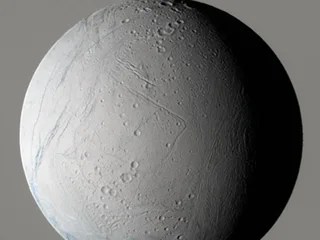1 min read

This false-color view, made on a previous flyby, shows that unlike other Saturn moons, the surface of Enceladus consists of entire regions that appear to be relatively crater-free.
On July 14, the Cassini spacecraft conducted its closest flyby yet, coming within 175 kilometers (109 miles) from the surface of the wrinkled, icy moon, Enceladus.
During Cassini's first flyby of Enceladus, a tenuous atmosphere was detected in magnetic field data, which may imply internal activity. This atmosphere may help explain the source of Saturn's outermost E ring.
The icy surface of Enceladus appears to have similarities to both Europa and Ganymede -- two prominent icy satellites of Jupiter. Both Europa and Ganymede are thought to have subsurface water layers or "oceans," so the similarities with Enceladus are intriguing.
Date
July 14, 2005
Distance
107 miles (172 km)
Speed
18,343 mph (8.2 km/sec)
Share
Details
Last Updated
Jan 24, 2024
Editor
NASA Science Editorial Team
Related Terms
Keep Exploring







